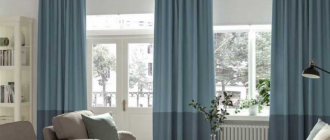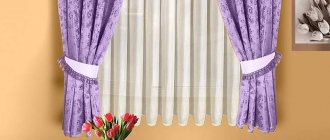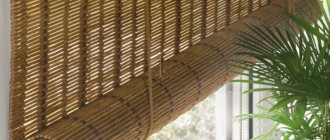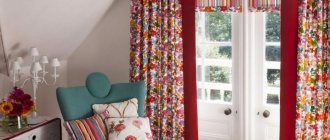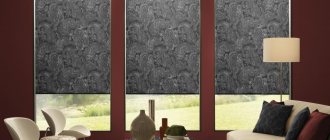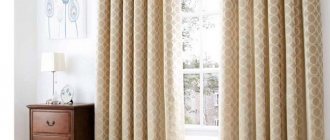Curtains are the calling card of any room, be it an apartment or an office. Successful window design will set the style of the entire interior and become its main accent. In order for the curtains to fit perfectly into the design, it is not enough to choose the right fabric, you need to correctly calculate their parameters. Knowing how to choose the size of curtains depending on the type of fastening and model, you can cope with this task in a matter of minutes. Therefore, howbuysell will share some secrets of the right actions.
Taking measurements
It is inconvenient to use a tailor's meter when measuring; it is better to take a hard metal tape measure.
To calculate the width of curtains, take as a basis:
- suspension length;
- fabric fluffiness factor (this is a separate topic for discussion);
- allowances for edge processing.
The main parameter is width
When choosing a curtain or cornice, you need to remember the golden rule: the curtain hanger should be up to 50 cm longer than the width of the window.
When open, the curtains should not interfere with the penetration of sunlight; the window opens completely. In narrow rooms, the wall is draped across its entire width - visually the space expands.
When measuring a hanger, measure its working distance - the width of the rail, string or rod along which the curtain will move. This is the main parameter when calculating the amount of fabric for curtains.
Learning to correctly calculate the length of the cornice in relation to the window
When making measurements and calculations, you should be guided by the following principles:
- The length of the cornice can be 100-400 mm wider than the window opening;
- Its wall-to-wall fastenings should be located 2-3 cm narrower than the window opening;
- Every one and a half to two meters it is necessary to provide fastening. This will help the curtain rod to stay firmly on the wall, because curtains are not a light thing, and they are also subject to constant outside interference. When installing a ceiling cornice, it is worth installing fastenings every 50 cm.
This means that in order to choose the correct length of the cornice, use a tape measure or measuring tape to measure the width of the window opening. Add from 100 to 400 mm to the resulting figure. The parameter will depend on the density of the fabric and the size of the room. Wide curtain rods are suitable for massive draped fabrics and will also make the room visually larger. Divide the length obtained during the calculation by two. This way you will get the required number of fasteners
It is important to understand that if the length of the cornice is less than 3 meters, 2 support points will be enough, for other cases it is necessary to secure it in 3 places
There are rooms in which there are several windows on one wall. In this case, you can get by with one cornice for both openings, provided that the distance between the windows does not exceed half a meter. However, there are no strict regulations or requirements in this regard. Separate curtains will also look harmonious and pleasing to the eye.
Pomp factor
Curtains never hang perfectly evenly on a window; there should always be gathers or folds. Drapery is a standard design technique.
The number and depth of folds depend on the texture of the fabric and its weight. Generally accepted coefficients of pomp depending on the height of the ceilings.
How to calculate folds on curtains:
- the texture of organza allows you to make numerous folds, fabric consumption increases from 2 to 4 times (if there is a lot of pomp, you can limit yourself to one organza and not make curtains);
- tulle is purchased in 1.5–3 widths (the more airy the fabric, the greater the fluffiness factor can be provided);
- veils - from 1.5 to 2.5;
- silk – from 1.2 to 3;
- linen - from 1.5 to 4 (when attached to eyelets);
- mixed fabrics - from 1.5 to 3.5;
- velvet, jacquard, thick curtains - from 1.2 to 2.5.
Fabrics with large patterns or large floral prints should be completely straightened across the window to avoid tackiness. For them, folds and gathers are unacceptable. The type of assemblies depends on the type of fastening.
The highest coefficient of pomp is found in pencil folds and puffs. A little lower - near the curtain tape and eyelets. If the curtain hangs on hinges, it is not gathered much.
Standards
Standard parameters were derived from the ergonomics of typical rooms, in which windows and walls are almost the same size, so there are no problems with length
But the textile industry offers a wide range of fabrics, from very light to heavy, massive, and fashion designers are coming up with more and more new styles, with folds, lambrequins, frills, multi-layered, so it is important when choosing a cornice to pay attention to:
- the material from which it is made;
- rail width, pipe thickness.
Diameter and length of metal pipes
The golden mean of metal pipes is considered to be D = 25-28 mm, suitable for almost all types of curtains. The standard for forged products is 16 mm. Hollow thin-walled products for light curtains have D = 16 mm, for more massive ones - 2.5-4.0 cm, depending on the manufacturer. In multi-row models, pipes of smaller (for tulle) and larger (for the main fabric) thicknesses are usually combined.
Mini cornices, designed for decorating small windows, under light curtains, have D = 1.0 cm, they do not overload the interior and do not sag like strings.
Double-row systems consist of a thin strip for tulle 10-16 mm, and a pipe D = 28 mm, for thick curtains. Usually they are covered on top with a decorative film that imitates natural materials, or with paint. Cornices with a diameter of 25 mm are made from stainless steel. Standard L = 160,180, 200, 240, 280, 300, 320, 360 cm. You can also buy solid metal rods with a diameter of 28-50 mm, a length of 6 m.
If the window has a wide sill or a heating system runs along the plane, pay attention to the length of the bracket, optimally from the wall to the inside of the eaves 10-15 cm
Standards for wooden cornices
Wooden curtain rods are inferior to metal ones in strength, so the standard for products is considered to be D = 28 mm, which is suitable for light and medium-weight curtains. If you need to hang heavy curtains, you should install holders every meter, which is not always convenient for opening.
Rods D = 16, 28, 35 mm come in a maximum length of 2 m; for wide openings you will need to connect 2 pieces through a bracket.
Choose products made from durable wood to prevent sagging over time.
Standards for plastic models
The maximum length of a plastic bus is 4 m. Double-row cornices are produced with a width of 8.0 cm, three-row – 8.7 cm, L = 150, 180, 210, 250, 280, 300, 320, 340, 360, 380 cm.
Each manufacturer can set its own dimensions, so sometimes these parameters vary slightly
Classic molding cornices made of plastic have a decorative strip included, its width is 5 or 9 cm; wider ones, 100, 150-300 mm, are less common; these are small collections, more experimental.
Plastic rods have a standard D = 28 mm, the parameter for light models is 12, 16 mm, suitable for kitchen curtains, in the bathroom, for windows in children's rooms. L = 200, 240, 300, 360 cm.
How much to leave on the edges
For edge processing, up to 3 cm is usually left on both sides. When the edge is stitched, the curtain looks finished.
Raw edges on thick curtain fabrics are allowed. During factory production, the edges of the canvas are made rigid. Sometimes it is enough to remove single threads, and the edge of the curtain is ready.
Curtains for the bedroom - 135 photos of the best new products and exclusive designs. Review of unusual design options and combinations of curtains in the bedroom interiorCurtains for suspended ceilings - features of design and selection of curtains for interiors (135 photos)
- How to decorate curtains - useful tips and options for the best decoration ideas on 115 new photos!
Deciding on the length
When decorating interiors, a variety of curtain lengths are acceptable. In children's rooms and kitchens, curtains up to the window sill or 10-15 cm lower are acceptable.
Long ones are appropriate in living rooms and bedrooms. They can lie on the floor, be 1.5-2 cm higher. Much depends on the taste of the owners and the overall design solution.
The type of fastening must also be taken into account:
- if the curtain hangs on loops, the length is measured from their beginning;
- the curtain tape is attached at any height; if desired, you can cover the cornice with a curtain - the extreme point of measurement is selected independently;
- when attaching curtains to eyelets, the length is calculated from the outer edge of the rod with a margin of 2 cm (this is the minimum distance from the edge to the eyelet).
To decorate the bottom edge, you need to leave 5 to 8 cm. On light fabrics, a weight cord is inserted into the edge.
It is necessary to provide for the “shrinkage” of the fabric after washing. Linen, curtains based on natural fabrics are reduced in length by up to 10%.
If the ceiling height is 2.5 meters, add 2.5 cm. If the ceilings are high, you need to add up to 5 cm. Knowing all these basic rules, you can independently calculate the footage of the curtains.
Austrian curtains - the best models with interesting tailoring options in the interior + 150 photos- Sheer curtains are an option that will help keep the interior light and cozy +140 photos
- Art curtains - 125 photos of modern curtains with exceptional interior design!
Recommendations for choosing curtains
The design of your room also determines what length the curtains will look best and fit perfectly into the interior. Let's look at how to choose the ones you need.
- Buy curtains that match the color of the furniture or carpet; it’s beautiful when the window covering matches the color of small decorative elements in the room, such as sofa cushions or lamps. Try not to choose curtains of the same shade as the wallpaper, otherwise the colors will merge, and this will not look very nice.
- If you prefer curtains without a pattern, monochromatic, then they need to be matched to the design of the rest of the room, not only in color, but also in the texture of the material. Let them match, for example, with bedspreads or pillow covers.
- Curtains with an ornament need to be matched to some decorative elements or accessories, if it was not possible to match the furniture upholstery or carpet (which would be an ideal option).
- You should think about the model of future curtains in advance. Classic models are appropriate in any room, but unusual ones, decorated with various special details, must be carefully selected to suit the decor. You must decide what kind of drapery will be on the canvas, you can even draw how you want the future decorated window to look, calculate the footage of the room and figure out which curtains will be suitable for it - for small rooms or large ones. And only after that start taking measurements.
- If there is little light in the room, then be careful in applying all kinds of decorations to the curtains, and it is better to do without them. This will make the room seem more spacious. Let the curtains be light, loose, allowing as much light into the room as possible.
- The most practical fabrics for curtains are polyester or a polyester-cotton mixture. They do not get dirty for a long time and are easily machine washable without losing their shape. You can also wash viscose curtains at home. And, for example, it is better to dry clean velvet curtains.
- Linen curtains, shiny and thin, look great in the kitchen. Linen in such fabrics can be with various additives, which gives even more gloss to the fabric. If you choose velvet or silk curtains, then they need a lining; it will protect the delicate fabric from fading and hide the seams. The length of curtains in the kitchen should not be very long; curtains up to the level of the window sill are perfect.
- For low ceilings, hang curtains with vertical stripes to make them appear higher. And to increase the width of the room, you need to take curtains with horizontal stripes.
- Lambrequin looks good in rooms with high ceilings; it is not suitable for low ceilings, as it visually makes them even lower. For compact rooms, take a closer look at straight lambrequins or in the form of an arch; they will expand the space. The color of the drapery may differ from the chosen color of the curtains, but the texture of the fabric must match for the window design to be harmonious. The dark lambrequin looks nice against the light background of the other curtains.
- Lush voluminous draperies fit into the interior of rooms only with high ceilings, do not forget about this. The smaller and lower the room, the smoother the curtains you choose for them.
To make the interior design complete, consider the following points:
- curtains must be longer than the height of the draped window, otherwise the room will look sloppy and harmony in the interior will disappear, besides, long curtains hide the shortcomings of the window sill when it is not located parallel to the floor;
- be sure to pay attention to the folds of the fabric; it is advisable that they be located symmetrically, giving a decent appearance to the room;
- if the window is located in a niche, then choose draperies up to the window sill; the same applies to horizontal windows of modern houses;
- if you plan to secure the canvas to the window with decorative tie-backs, then you need to add a few more centimeters to the required length; in this case, you can also first draw on paper what it should look like, and then, knowing the dimensions of your window, determine the length of the curtains based on your drawing and desire;
- it is permissible to purchase long curtains for the kitchen only if it is spacious, with high ceilings and the window is located at a sufficiently large distance from the stove and sink, otherwise there will be a risk of not only ruining the curtain, but also the entire apartment due to the creation of a fire hazard;
- Please note that materials such as linen and cotton may shrink slightly in size after washing, so it is advisable to purchase curtains made from them with a reserve, or order or buy draperies from a mixed fabric, which is less susceptible to shrinkage;
- the higher the ceilings in the room, the more luxurious the drapery with the edge lying on the floor looks, but with low ceilings this option will visually make the room even smaller in height;
- Curtains should never be shorter than a transparent tulle curtain, otherwise all the beauty of the expensive fabric will fade and the window design will look ridiculous and ridiculous.
Before ordering curtains, calculate everything inside and out, consider different options, discuss possible models with your household, and if possible, it’s better to contact a professional designer. And with your decision already made, feel free to go to the store or order selected curtains on the Internet. Then the design of your window will fit perfectly into the interior and will bring you joy and pleasure.
Save
Save
We buy fabric
Knowing the required length and width of the curtains, you need to buy the right amount of fabric. Standard web width in rolls:
- light fabrics (tulle, veil, organza) – 2 m 80 cm;
- curtains - from 1 m 40 cm to 3 m.
How to correctly calculate curtains if the width of the fabric is not a multiple of the width of the curtains? If you need three lengths, you can make three separate curtains.
If asymmetry is inappropriate, the curtains must be sewn. It is better to do this with a linen seam. For this, it is necessary to provide an additional 3 cm for each curtain.
To calculate the total amount of fabric, simply multiply the height of the curtain, taking into account all allowances, by the number of segments.
It is more difficult to purchase fabric with a large pattern or a floral print that is now fashionable.
It is necessary to measure the height of the report. It should be repeated on the curtains an equal number of times. When purchasing fabric for curtains, it is measured only from the beginning of the print or pattern.
You may have to overpay, but the curtains will look organic. Large designs will require more fabric than small floral prints or plain drapes.
Material calculation examples
For clarity of the above recommendations, we will give several examples of calculations, taking conventional measurement values: let the distance between the extreme points of the cornice be 3 m, the height of the curtain 4 m.
Curtain with medium gathering
Length: curtain height + top hem + bottom hem (4+0.2+0.1 = 4.3 m);
Width: cornice length*assembly factor (3*2.5=7.5 m);
Triple pleated curtains
Lengthwise: curtain height + top hem + bottom hem (4+0.2+0.1 = 4.3 m);
Width: cornice length * assembly factor (3*3 = 9 m). Divide by 2, according to the number of canvases.
If you decide to experiment with style by choosing an exotic curtain model, contact a specialist to calculate their size; this will help you avoid mistakes and financial losses. And simple options can be calculated independently. Don't forget to keep the piece of paper with your measurements written down - it will come in handy the next time you change the curtains.
If you change your mind about doing needlework, you can choose ready-made curtain models according to our recommendations.
conclusions
When making curtains yourself, it is important to take into account all allowances. They can range from 8 to 40 cm (with eyelet fastenings).
Chintz shrinks the most, and linen shrinks a little less. Synthetic curtains retain their shape for a long time, but are more likely to fade.
Silk becomes brittle when exposed to the sun and crumbles over time. When choosing short curtains for the kitchen or nursery, it is better to buy fabric with a margin in order to create a thick bottom edge.
It can be glued with thermal tape or a weight cord inserted. Taking these nuances into account, you can make chic curtains yourself that will delight you for a long time.
Photo tips on how to calculate curtains
Read here Wall curtains: an element of interior decor, 110 photos of any style and design
Did you like the article? Share 



